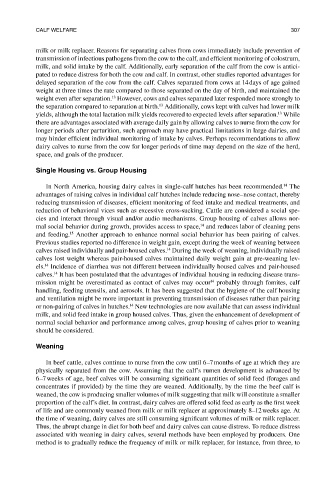Page 330 - The Welfare of Cattle
P. 330
CaLf WeLfare 307
milk or milk replacer. Reasons for separating calves from cows immediately include prevention of
transmission of infectious pathogens from the cow to the calf, and efficient monitoring of colostrum,
milk, and solid intake by the calf. Additionally, early separation of the calf from the cow is antici-
pated to reduce distress for both the cow and calf. In contrast, other studies reported advantages for
delayed separation of the cow from the calf. Calves separated from cows at 14 days of age gained
weight at three times the rate compared to those separated on the day of birth, and maintained the
13
weight even after separation. However, cows and calves separated later responded more strongly to
13
the separation compared to separation at birth. Additionally, cows kept with calves had lower milk
13
yields, although the total lactation milk yields recovered to expected levels after separation. While
there are advantages associated with average daily gain by allowing calves to nurse from the cow for
longer periods after parturition, such approach may have practical limitations in large dairies, and
may hinder efficient individual monitoring of intake by calves. Perhaps recommendations to allow
dairy calves to nurse from the cow for longer periods of time may depend on the size of the herd,
space, and goals of the producer.
Single housing vs. Group housing
In North America, housing dairy calves in single-calf hutches has been recommended. The
14
advantages of raising calves in individual calf hutches include reducing nose–nose contact, thereby
reducing transmission of diseases, efficient monitoring of feed intake and medical treatments, and
reduction of behavioral vices such as excessive cross-sucking. Cattle are considered a social spe-
cies and interact through visual and/or audio mechanisms. Group housing of calves allows nor-
14
mal social behavior during growth, provides access to space, and reduces labor of cleaning pens
and feeding. Another approach to enhance normal social behavior has been pairing of calves.
15
Previous studies reported no difference in weight gain, except during the week of weaning between
14
calves raised individually and pair-housed calves. During the week of weaning, individually raised
calves lost weight whereas pair-housed calves maintained daily weight gain at pre-weaning lev-
14
els. Incidence of diarrhea was not different between individually housed calves and pair-housed
calves. It has been postulated that the advantages of individual housing in reducing disease trans-
14
mission might be overestimated as contact of calves may occur probably through fomites, calf
14
handling, feeding utensils, and aerosols. It has been suggested that the hygiene of the calf housing
and ventilation might be more important in preventing transmission of diseases rather than pairing
14
or non-pairing of calves in hutches. New technologies are now available that can assess individual
milk, and solid feed intake in group housed calves. Thus, given the enhancement of development of
normal social behavior and performance among calves, group housing of calves prior to weaning
should be considered.
Weaning
In beef cattle, calves continue to nurse from the cow until 6–7 months of age at which they are
physically separated from the cow. Assuming that the calf’s rumen development is advanced by
6–7 weeks of age, beef calves will be consuming significant quantities of solid feed (forages and
concentrates if provided) by the time they are weaned. Additionally, by the time the beef calf is
weaned, the cow is producing smaller volumes of milk suggesting that milk will constitute a smaller
proportion of the calf’s diet. In contrast, dairy calves are offered solid feed as early as the first week
of life and are commonly weaned from milk or milk replacer at approximately 8–12 weeks age. At
the time of weaning, dairy calves are still consuming significant volumes of milk or milk replacer.
Thus, the abrupt change in diet for both beef and dairy calves can cause distress. To reduce distress
associated with weaning in dairy calves, several methods have been employed by producers. One
method is to gradually reduce the frequency of milk or milk replacer, for instance, from three, to

